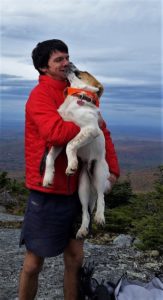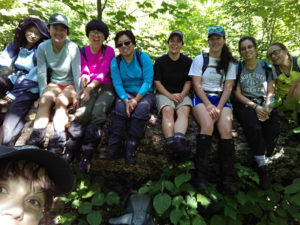When on the trail, please remember to:
Twenty thousand visitors enjoy the subarctic alpine areas on Mount Mansfield, Camel’s Hump and Mount Abraham annually. Plants there survive harsh winters, but they can’t take trampling.
- Please walk only on bare rock, and stay on the trail.
- Follow Leave No Trace guidelines. Consult the Long Trail Guide or call GMC for information. (802) 244-7037.
- Leash your dog(s).
Control Your Pet
Please be considerate of others.
 Yield to other hikers; they may not appreciate your dog’s company.
Yield to other hikers; they may not appreciate your dog’s company.- Leash your dog in alpine areas, at shelters, on crowded summits, and at trailside ponds.
- Leash your dog unless you have guaranteed voice command.
- Keep your dog out of water sources and away from hikers’ packs and food.
- Canine waste threatens health as much as human waste. Carry wagbags to collect waste above tree line. Below tree line dig catholes 6 to 8 inches deep, 200 feet from trails, shelters, and water sources.
- Pack a tent, and share it with your dog unless others are happy to share a shelter with a dog.
Keep Bears and Other Wildlife Safe
Bears are becoming more numerous and more active. Though usually shy and unaggressive, bears that have sampled human food can become dangerous, putting their lives at risk. Help bears stay safe:
- If you encounter a bear, stay calm, keep eye contact, talk to the bear in a conversational voice, and back away slowly. Do not run.
- Do not feed or approach bears.
- Do not keep food, trash or scented items in a shelter or tent. Use bear boxes where provided; hang your food, toiletries and trash high at least 100 feet from camp; or carry and store them in a bear canister.
- Pack out all garbage and food scraps.
- Report bear encounters to the GMC.
Use Your Cell Phone Responsibly
Many people head to the Long Trail to enjoy the quiet backcountry, but may carry cell phones for emergencies. Please be considerate and follow these simple guidelines:
- Carry and use phones out of sight and sound of other people.
- Keep phones off until needed, or keep in a pocket on the “vibrate” or “silent” ringer setting.
- Don’t leave ill prepared, or take risks because you can call for help. A phone is no excuse for poor planning and preparation.
- Remember backcountry coverage is often poor or non-existent.
Walk Through Mud
Let’s face it. Parts of the Long Trail are muddy year-round, so trail damage can happen anytime. Detouring mud damages trailside soil and vegetation, and expands the mud. Please walk through mud rather than around it whenever you can.
Use the Group Notification System
- If planning a group outing, contact GMC’s Group Outreach Coordinator to submit itineraries for the Group Notification Calendar.
- Respect size limits. Ten people, including leaders, is the limit for overnight hikes and day hikes to alpine summits, fragile ponds or federally designated wilderness areas.
- For day hikes to other destinations the group size limit is 20, including leaders. Larger groups should divide into two groups or more, and stagger departure times by 30 minutes. Do not recombine at shelters, summits or fragile shorelines.
- Keep the leader-to-participant ratio one to four.
- Stay at designated group overnight sites.
- Be considerate of others, and leave shelter space for individual hikers. Groups of four or more should tent at designated sites near shelters.
Consider Alternatives to Campfires
Everyone loves campfires. But before you build one, consider: what would be the impact if everyone built one there?
Instead of a campfire:Carry a backcountry stove and fuel.
- Use a solar-powered lantern, battery candles, or a headlamp wrapped around a water bottle to light an area.
If you do build a fire:
- Use an established fire ring (never build a new ring) when on private land, or on state land below 2,500 feet. Small fires are permitted on federal land in some areas—check the Long Trail Guide for detailed information.
- Follow the 4 Ds of gathering firewood:
- Downed—use wood found on the forest floor.
- Dead—use sticks that will burn completely to ash.
- Dinky—use small pieces of wood (no larger than the diameter of an adult wrist) that can be broken by hand.
- Distant—gather wood well away from camp.




















Hello! The advice listed above and that included in “Be Bear Aware” are contradictory regarding eye contact. Which is correct, keep eye contact or do not make eye contact if you encounter a bear? Thanks!
Thank you for bringing this to our attention! The correct thing to do with black bears is to maintain eye contact. (Source: https://www.benkilham.com/Benkilham.com/Understanding_Bear_Behavior.html)